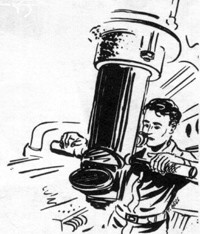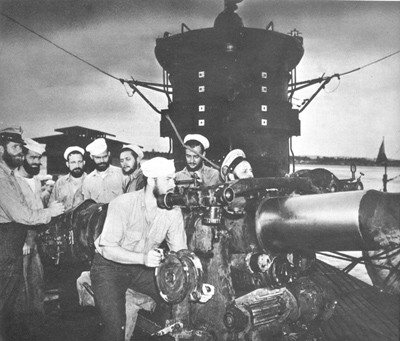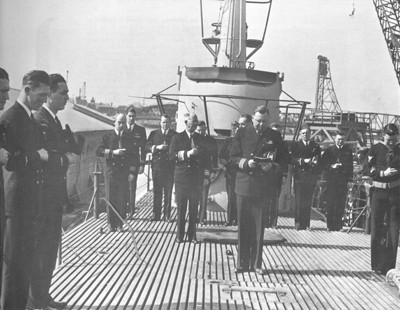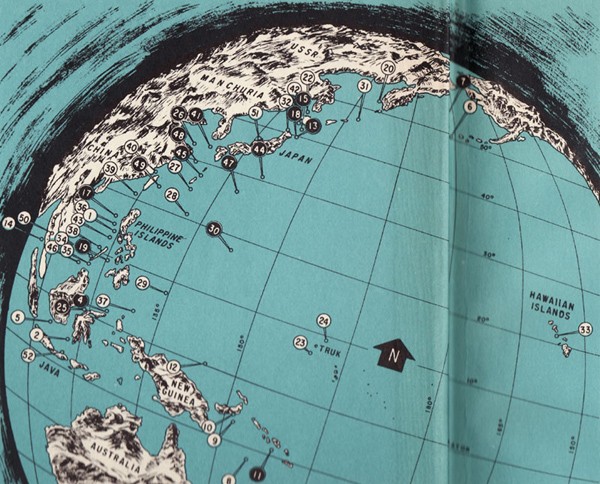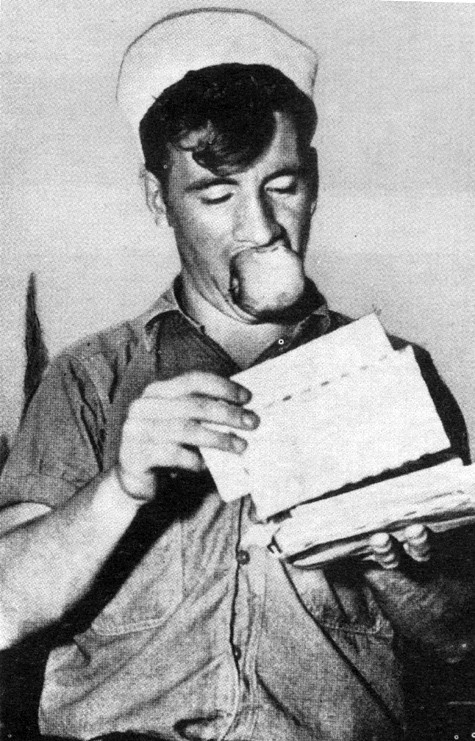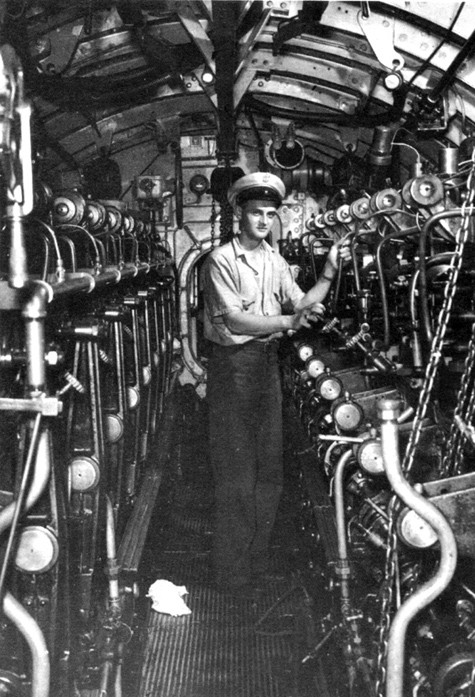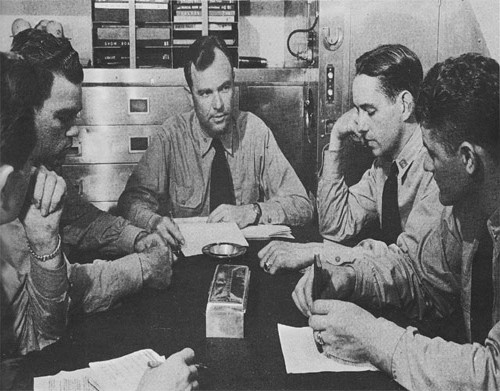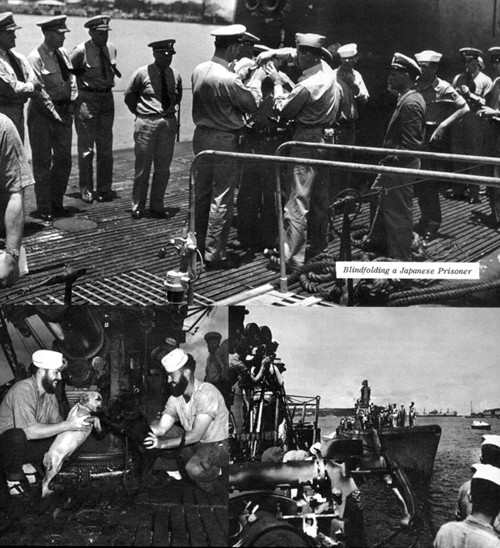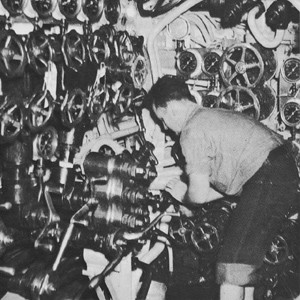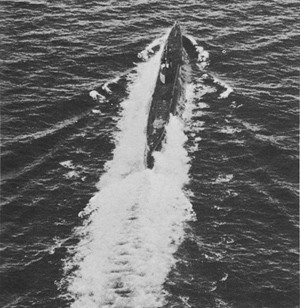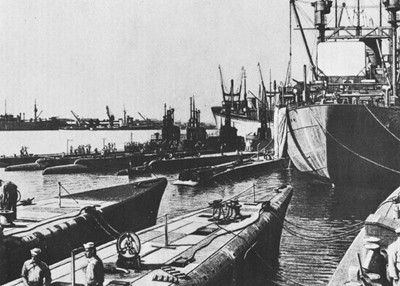
The Navy Department Library
Introduction
The submarines paid heavily for their successes in World War II. A total of 52 submarines were lost, with 374 officers and 3,131 enlisted men. These personnel losses represented 16% of the officer and 13% of the enlisted operational personnel. Of the 52 losses, two submarines, Dorado and R-12, were lost in the Atlantic, S-26 was sunk in a collision off Panama and S-28 was an operational loss in training at Pearl Harbor. The remaining 48 were lost either directly or indirectly as the result of enemy action, or due to stranding on reefs during combat operations. S-39, S-36, S-27 and Darter were lost as the result of such strandings. In all these strandings all personnel were rescued.
In the cases of the losses due to enemy action, three officers and five men from Flier and all but four men from Sealion were saved. The remaining submarines were lost with all hands, though some personnel from Grenadier, Perch, Sculpin, Tang, two men from S-44 and one from Tullibee were repatriated at the end of hostilities, having been held as prisoners of war by the enemy. Four men were said to have survived Robalo's sinking but they were not recovered following the end of the war, and it is assumed that they perished as prisoners of the enemy.
The 52 submarines represent approximately 18% of all submarines which saw combat duty. This loss of 18%, while high in comparison to the losses sustained by other types of ships of the Allied Forces, is considered remarkably low when considered in relation to the results achieved, or when compared with the losses sustained by enemy submarine forces. The Germans, in World War I, lost 178 submarines of a total of 272 submarines in commission during that war, and in World War II they lost between 700 and 800 submarines. With but meager results to show for their submarine effort, the Japanese in World War II lost 128 submarines and had but 58 remaining at the end of hostilities, many of the remaining 58 being nonoperational.
--1--
In analyzing our losses, the following factors are considered as having been responsible for the low figure as compared to those of our enemies:
| 1. | Excellent mental and physical condition of our submarine personnel, and their high state of training. |
| 2. | Superiority of our radar over that of the Japanese. |
| 3. | Weakness of Japanese antisubmarine measures. |
Submarine crews, upon their return from a war patrol, were transferred to a Rest and Recuperation Camp for a period of two weeks while their submarine was being refitted by a relief crew. During this two week period the regular crew had no official duties to perform other than to rest and relax and divorce their minds from all thoughts of war and combat. There were some who criticized this practice as being in the nature of pampering. The submarine force commanders vigorously defended it as being not a luxury but a vital part of submarine warfare. War patrols, normally lasting from 45 to 60 days, introduced a protracted mental tension unknown to other types of warfare. Without the rest periods to ease this tension the personnel would soon have cracked up under the strain. As a result of the rest and recuperation policy submarine crews went to sea mentally and physically alert and it is considered that this was the primary factor in keeping our losses to a minimum. Hand in hand with the excellent mental and physical condition of our personnel was the high state of training in which they departed on patrol. Prior to a submarine's first patrol she was given an extensive training period, either on the east coast or at Panama, followed by advanced training in the Pearl Harbor area. Immediately preceding departure upon subsequent patrols, the submarine was given an intensive refresher training period, lasting from four to eight days. Training kept pace with enemy antisubmarine measures, new training methods being introduced to counter the latest trends in enemy offensive or defensive measures.
The superiority of submarine radar, as compared to that of the Japanese antisubmarine forces, was another factor contributing much to keeping our losses low.
--2--
Submarines started the war without radar, but within a few months all were equipped with the SD (aircraft warning) radar. The SD, by giving early warning of the approach of planes, did much to prevent surprise air attacks on surfaced submarines. The installation of the SJ (surface search) radar a few months later did the same to prevent the undetected approach of enemy surface craft during darkness and low visibility. When it became apparent that enemy electronic science had progressed to the point where they were able to produce efficient radars, the APR was developed to warn of their presence, and later, the ST and SV radars, using shorter waves than the SD and SJ, were installed to combat the enemy's quite successful efforts to detect our own radars.
At the start of the war, enemy antisubmarine materiel was comparable with our own; their listening and echo ranging gear were practically duplications of that installed in our own antisubmarine vessels. The Japanese in certain fields have been notoriously poor inventors but great copyists, and with their espionage services cut off during the war, they rapidly fell behind in the development of antisubmarine measures. And although their original equipment was good, their technique of employing it was faulty. They seemed to have little trouble in locating a submarine with their listening gear following a torpedo attack, but having located her, they failed miserably in the solution of the mathematical problem of where to drop their depth charges. Their attacks were characterized by a consistent lack of persistence. They were prone to accept the most nebulous evidence as positive proof of a sinking, and being sure of a kill, they were off about their business, letting the submarine surface and thank God for the Japanese superiority complex. While only 48 submarines were lost in combat operations--and of these not more than 41 directly due to enemy action--the Japanese, at the end of hostilities, furnished us with information which showed a total of 468 positive sinkings of our submarines. The U.S. Navy, by a wise policy of total censorship of submarine operations, encouraged the enemy in their belief in their antisubmarine successes. When we failed to announce the successful attacks of our submarines, the enemy naturally assumed they never got home to report them.
The chart on the following page shows the known or estimated positions of all submarine losses in the Pacific. The estimated positions must be accepted with caution - at best they are only fair guesses. In several cases submarines departed from their bases for patrol and were never heard from again. In such cases the estimated position is given as inside the area to which the submarine was assigned but the loss might have occurred anywhere between that area and the base. In general, solid dots have been placed on the chart where the position of the loss is known with reasonable certainty to have occurred within the area covered by the dot. Open dots have been used where positions are not certain, due to circumstances explained in the text.
Assuming these estimations are correct, a study of the chart will reveal some amazing facts, as for example:
| a. | Not a single submarine was lost in Central Pacific waters until the loss of Pickerel in April 1943, sixteen months after the start of the war. |
| b. | The area south of Honshu, at the entrance to Tokyo Bay, and at the Kii Suido and Bungo Suido entrances to the Inland Sea, would normally be considered the areas where enemy antisubmarine measures would be most intensive. Yet, although these areas were constantly and heavily patrolled during the entire war, not a single submarine was ever lost along the southern coast of Honshu. |
| c. | Next to the southern Honshu areas, the most intense enemy antisubmarine measures could be expected at his strongest outposts--Truk and Palau. Yet the war was two years old before the first of two submarines was lost near Truk, and information indicates that the only loss near Palau--Tullibee in March 1944--was caused by a circular run of one of her own torpedoes. |
| d. | The shallow waters of the Yellow Sea made submarine evasive tactics difficult, and permitted extensive defensive mining by the enemy, yet only two submarines were lost in that area, and none during the last ten months of the war when the greater part of all submarine offensive patrols were concentrated therein. |
--4--
--5--
| O Indicates Know Position * Indicates Estimated Position |
|||
| 1. | Sealion | 12-10-41 | |
| 2. | S-3 | 1-20-42 | |
| o | 3. | S-26 | 1-24-42 |
| 4. | Shark I | 2-11,12-42 | |
| 5. | Perch | 3-3-42 | |
| 6. | S-27 | 6-19-42 | |
| 7. | Grunion | 7-30, 8-6-42 | |
| 8. | S-39 | 8-13,14-42 | |
| 9. | Argonaut | 1-10-43 | |
| 10. | Amberjack | 2-16-43 | |
| 11. | Grampus | 3-5,6-43 | |
| 12. | Triton | 3-15-43 | |
| 13. | Pickerel | 4-3-43 | |
| 14. | Grenadier | 4-22-43 | |
| 15. | Runner | 5-28, 7-4-43 | |
| o | 16. | R-12 | 6-12-43 |
| 17. | Grayling | 9-12-43 | |
| 18. | Pompano | 8-29, 9-27-43 | |
| 19. | Cisco | 9-28-43 | |
| 20. | S-44 | 10-7-43 | |
| o | 21. | Dorado | 10-12-43 |
| 22. | Wajpp | 10-11-43 | |
| 23. | Corvina | 11-16-43 | |
| 24. | Sculpin | 11-19-43 | |
| 25. | Capelin | 12-9-43 | |
| 26. | Scorpion | 1-5, 2-24-44 | |
| 27. | Grayback | 2-26-44 | |
| 28. | Trout | 2-29-44 | |
| 29. | Tullibee | 3-26,27-44 | |
| 30. | Gudgeon | 4-7, 5-11-44 | |
| 31. | Herring | 6-1-44 | |
| 32. | Golet | 6-14-44 | |
| 33. | S-28 | 7-4-44 | |
| 34. | Robalo | 7-26-44 | |
| 35. | Flier | 8-13-44 | |
| 36. | Harder | 8-24-44 | |
| 37. | Seawolf | 10-3-44 | |
| 38. | Darter | 10-24-44 | |
| 39. | Shark II | 10-24-44 | |
| 40. | Tang | 10-24-44 | |
| 41. | Escobar | 10-17, 11-3-44 | |
| 42. | Albacore | 11-7-44 | |
| 43. | Growler | 11-8-44 | |
| 44. | Scamp | 11-9,16-44 | |
| 45. | Swordfish | 1-12-45 | |
| 46. | Barbel | 2-4-45 | |
| 47. | Kete | 3-20,31-45 | |
| 48. | Trigger | 3-26,28-45 | |
| 49. | Snook | 4-8,20-45 | |
| 50. | Llagarto | 5-3-45 | |
| 51. | Bonefish | 6-18-45 | |
| 52. | Bullhead | 8-6-45 | |
| o | Losses not shown on chart: Dorado, enroute New London to Panama October 1943. S-26, at Panama, January 1942. R-12 at Key West, Fla. June 1943. |
||
--5--
--6--
In the pages which follow, the circumstances surrounding the loss of each submarine, so far as they can be ascertained, are given. In each case, all evidence available at the time of this writing has been adduced in seeking to assign a specific cause for each loss, and to establish a definite position where the loss occurred. With the war so recently over, it will be obvious to every one that all returns are not in-that the coming years may be expected to divulge further information bearing on our submarine losses, and that the conclusions presented here will have to be modified as these data come to light. So for the benefit of future researchers, an outline of the data and methods used is in order.
The table which follows gives a condensed summary of the causes for the loss of each of our submarines which did not return, and an estimate as to the accuracy of the analysis. In preparing this summary and the descriptive matter covering the loss of each ship, the first source utilized was the operation order delineating her area and the dispatches sent to her and received from her during the patrol on which she was lost. Due to the necessity for submarines to maintain radio silence during their operations, information gleaned from incoming messages was usually sketchy. Any reports of enemy aircraft or surface craft in the vicinity of losses were taken into account; reports by other submarines of rendezvous with the lost craft were heeded; reports of enemy minefields in the area as signed each lost submarine were analyzed. Where statements by survivors of strandings or by repatriated prisoners of war who survived submarine sinkings are available, they have been taken as entirely authentic, and have been liberally used in forming the story of the loss.
--7--
A Summary of Submarine Losses
|
Accuracy of Analysis |
Enemy Action |
Friendly Forces |
Other |
|
|||||||||
Probable to Possible |
Certain to Probable |
Surface Craft |
Air Craft |
Sub |
Surface Craft |
Air Craft |
Mines |
Circular Runs |
Opera |
Stran |
Un |
|||
1. |
Sealion |
|
X |
|
X |
|
|
|
|
|
|
|
|
12-10-41 |
2. |
S-36 |
|
X |
|
|
|
|
|
|
|
|
X |
|
1-20-42 |
3. |
S-26 |
|
X |
|
|
|
|
|
|
|
X |
|
|
1-24-42 |
4. |
Shark I |
X |
|
X |
|
|
|
|
|
|
|
|
|
2-11,21-42 |
5. |
Perch |
|
X |
X |
|
|
|
|
|
|
|
|
|
3-3-42 |
6. |
S-27 |
|
X |
|
|
|
|
|
|
|
|
X |
|
6-19-42 |
7. |
Grunion |
|
|
|
|
|
|
|
|
|
|
|
X |
7-30, 8-6-42 |
8. |
S-39 |
|
X |
|
|
|
|
|
|
|
|
X |
|
8-13,14-42 |
9. |
Argo-naut |
|
X |
X |
|
|
|
|
|
|
|
|
|
1-10-43 |
10. |
Amber-jack |
|
X |
X |
X |
|
|
|
|
|
|
|
|
2-16-43 |
11. |
Grampus |
X |
|
X |
|
|
|
|
|
|
|
|
|
3-5,6-43 |
12. |
Triton |
|
X |
X |
|
|
|
|
|
|
|
|
|
3-15-43 |
13. |
Pickerel |
X |
|
X |
|
|
|
|
|
|
|
|
|
4-3-43 |
14. |
Gren-adier |
|
X |
|
X |
|
|
|
|
|
|
|
|
4-22-43 |
15. |
Runner |
X |
|
|
|
|
|
|
X |
|
|
|
|
5-28, 7-4-43 |
16. |
R-12 |
|
X |
|
|
|
|
|
|
|
X |
|
|
6-12-43 |
17. |
Grayling |
|
|
|
|
|
|
|
|
|
|
|
X |
9-9, 9-12-43 |
18. |
Pompano |
X |
|
|
|
|
|
|
X |
|
|
|
|
8-29, 9-27-43 |
19. |
Cisco |
X |
|
X |
X |
|
|
|
|
|
|
|
|
9-28-43 |
20. |
S-44 |
|
X |
X |
|
|
|
|
|
|
|
|
|
10-7-43 |
21. |
Wahoo |
X |
|
|
X |
|
|
|
|
|
|
|
|
10-11-43 |
22. |
Dorado |
X |
|
|
|
|
|
X |
|
|
|
|
|
10-12-43 |
23. |
Corvina |
|
X |
|
|
X |
|
|
|
|
|
|
|
11-16-43 |
24. |
Sculpin |
|
X |
X |
|
|
|
|
|
|
|
|
|
11-19-43 |
25. |
Capelin |
X |
|
X |
|
|
|
|
|
|
|
|
|
11-12, 12-9-43 |
26. |
Scorpion |
X |
|
|
|
|
|
|
X |
|
|
|
|
1-5, 2-24-44 |
27. |
Grayback |
|
X |
X |
X |
|
|
|
|
|
|
|
|
2-26-44 |
28. |
Trout |
|
X |
X |
|
|
|
|
|
|
|
|
|
2-29-44 |
29. |
Tullibee |
|
X |
|
|
|
|
|
|
X |
|
|
|
3-26,27-44 |
30. |
Gudgeon |
X |
|
X |
X |
|
|
|
|
|
|
|
|
4-7, 5-11-44 |
31. |
Herring |
|
X |
X |
|
|
|
|
|
|
|
|
|
6-1-44 |
32. |
Golet |
|
X |
X |
|
|
|
|
|
|
|
|
|
6-14-44 |
33. |
S-28 |
|
X |
|
|
|
|
|
|
|
X |
|
|
7-4-44 |
34. |
Robalo |
|
X |
|
|
|
|
|
X |
|
|
|
|
7-26-44 |
35. |
Flier |
|
X |
|
|
|
|
|
X |
|
|
|
|
8-13-44 |
36. |
Harder |
|
X |
X |
|
|
|
|
|
|
|
|
|
8-24-44 |
37. |
Seawolf |
X |
|
|
|
|
X |
|
|
|
|
|
|
10-3-44 |
38. |
Darter |
|
X |
|
|
|
|
|
|
|
|
X |
|
10-24-44 |
39. |
Shark II |
|
X |
X |
|
|
|
|
|
|
|
|
|
10-24-44 |
40. |
Tang |
|
X |
|
|
|
|
|
|
X |
|
|
|
10-24-44 |
41. |
Escolar |
X |
|
|
|
|
|
|
X |
|
|
|
|
10-17, 11-3-44 |
42. |
Albacore |
|
X |
|
|
|
|
|
X |
|
|
|
|
11-7-44 |
43. |
Growler |
|
|
|
|
|
|
|
|
|
|
|
X |
11-8-44 |
44. |
Scamp |
|
X |
X |
X |
|
|
|
|
|
|
|
|
11-9,16-44 |
45. |
Swordfish |
X |
|
X |
|
|
|
|
X |
|
|
|
|
11-7-44 |
46. |
Barbel |
|
X |
|
X |
|
|
|
|
|
|
|
|
2-4-45 |
47. |
Kete |
|
|
|
|
|
|
|
|
|
|
|
X |
3-20,31-45 |
48. |
Trigger |
|
X |
X |
X |
|
|
|
|
|
|
|
|
3-26,28-45 |
49. |
Snook |
|
|
|
|
|
|
|
|
|
|
|
X |
4-8,20-45 |
50. |
Lagarto |
|
X |
X |
|
|
|
|
|
|
|
|
|
5-3-45 |
51. |
Bonefish |
|
X |
X |
|
|
|
|
|
|
|
|
|
6-18-45 |
52. |
Bullhead |
|
|
X |
|
X |
|
|
|
|
|
|
|
8-6-45 |
--8--
When the war began, submarines operated alone and in far flung areas. The paucity of contacts with them by other ships and their operational commanders makes it difficult to establish definitely small areas, both in time and in position, where their loss occurred. As the war progressed and woIf packs came into being, the frequent exchange of information among members of the pack gives much more material concerning ships lost while patroling as members of packs.
The chief source of information as to attacks made on U.S. submarines by the enemy has been provided by the Japanese since war's end. The list consists of two parts, both exact translations, and purports to be a list of positive sinkings. The first part gives the date and place of attacks made on U.S. submarines; the second is an amplifying report which gives further information on each attack. An attached note states that those attacks whose dates or locations are uncertain have been eliminated by the Japanese. The enemy was prone to accept the most inconclusive evidence as proof that a submarine was sunk, and, from that point of view, it would seem that the list should be fairly complete. Yet the definite possibility exists that one or more of
--9--
--10--
the attacks not reported because it was thought to be ineffective or because the date or position was garbled might explain the loss of one of our submarines whose end is now only a matter for conjecture. Furthermore, the report states that the record of April 1943 is imperfect and that "since about July 1943 more strict investigations have been gradually instigated to confirm the sinkings, but the reports of the sinkings prior to this date are listed here without further investigations." In the cases of a great many attacks made before July 1943, only positions and dates are given-no information is available even as to whether the attacks were by surface ships, planes or submarines, much less concerning evidence to confirm sinkings. Moreover, Japanese records are notoriously ill kept, and several instances where the descriptive matter concerning an attack has been linked with the wrong item in the date-position list have been discovered. Although seven submarines gave up prisoners of war to the Japanese, only four attacks in which American prisoners were taken are listed in the report. The number of antisubmarine attacks which, for one reason or another, never were reported to any central Japanese agency will probably never be known. Excellent circumstantial evidence indicates that at least one of our submarines, Grampus, was lost as the result of an attack by two enemy destroyers who were themselves sunk shortly thereafter and thus never reported the attack. Also the poor coordination evident in the Japanese military and naval organizations may mean that records of attacks made in outlying places received poor handling.
For purposes of the summary table, the category "Probable to Certain" conveys that the evidence at hand is deemed at least complete enough to present a reasonably strong case for the analysis presented; "Possible to Probable" implies that no specific information can be adduced to support any conclusion as to the cause of the loss, but one particular cause seems a great deal more likely than any other; "unknown" covers a multiplicity of indeterminable causes, none of which can be chosen as any more likely than the others. Throughout, it must be kept in mind that Japanese claims and reports are considered by no means complete or accurate. "Operational" losses are those caused by errors of personnel incorrectly handling the ship, by fatal breakdown of the ship itself, or by any other accident short of direct enemy action or stranding which might cause the ship and personnel to be lost. The term "circular run" refers to the tragic phenomenon in which a submarine's torpedo, due to some defect, runs in a circle and shortly arrives at the point from which it was fired.
Summary--Causes of Submarine Losses
| Certain To Probable | Probable To Possible | Total | |
|---|---|---|---|
| Enemy Surface Ship Attacks | 12 | 4.5 | 16.5 |
| Enemy Aircraft Attacks | 4 | 1 | 5 |
Enemy Cooperative Aircraft-Surface |
4 | 2 | 6 |
| Enemy Submarines | 1 | 0 | 1 |
| Friendly Surface Forces | 0 | 1 | 1 |
| Friendly Aircraft | 0 | 1 | 1 |
| Enemy Mines | 3 | 4.5 | 7.5 |
| Circular Runs | 2 | 0 | 2 |
| Operational | 3 | 0 | 3 |
| Stranding | 4 | 0 | 4 |
| Unknown | --- | --- | 5 |
| TOTAL | 33 | 14 | 52 |
In the summaries of patrol results, the figures for ships sunk and damaged are the officially credited ones, except in the cases of major combatant vessels. The latter have been correlated with official Japanese lists of combat ship losses, and only those ships actually confirmed as sunk are mentioned here. In the cases of small combatant and merchant ships, the officially accredited results are based on the Commanding Officer's own estimate of results achieved during the patrol, modified as deemed necessary by higher authorities. It is apparent, therefore, that such figures are subject to normal human error, and may not be completely correct.
Lastly, it must be mentioned that in searching Japanese records to locate attacks which might have spelled doom for our lost submarines, a great many assumptions have been made. Where only one attack can be tied in with a loss, it has been designated the most probable cause of the loss. This, it is realized, may be leaving out much of the story, for, while it is perfectly possible for an accurately placed depth charge or bomb to sink a submarine immediately, the amount of damage sustained and survived by U.S. submarines during this war is nothing short of amazing. Undoubtedly, many stories of heroic fights to control damage are locked forever in the depths beneath the waves. Many submarines could have survived for some time beyond the attack which later proved fatal, and are therefore not likely to be found at the last known position. That these stories cannot be told can only be lamented as one of the minor tragedies of war.
***********
The Naval History and Heritage Command gratefully acknowledges Charles R. Hinman, Director of Education & Outreach, USS Bowfin Submarine Museum & Park; and Paul W. Wittmer, a World War II submarine veteran and author, for their research and suggestions for updating the 1963 edition of this book. Sources consulted by Hinman and Wittmer include: (1) individual personnel files for each of the 3,628 men lost on US submarines in World War II, located at the National Personnel Records Center in St. Louis, Missouri; (2) US Navy Casualty Lists, Book 11, pp. #2042 - #2152, Submarine War Patrols, Pacific - 7 December 1941 to 2 September 1945, National Archives and Records Administration (NARA), College Park, Maryland; (3) Defense POW/MIA Accounting Agency (DPAA) list at http://www.dpaa.mil/OurMissing/WorldWarII/ServicePersonnelNotRecoveredFollowingWWII.aspx; (4) muster rolls of each submarine, whenever applicable and available from NARA, College Park, Maryland, and (5) U. S. Rosters of World War II Dead, 1939-1945, available online at Ancestry.com.
--11--
--12--

